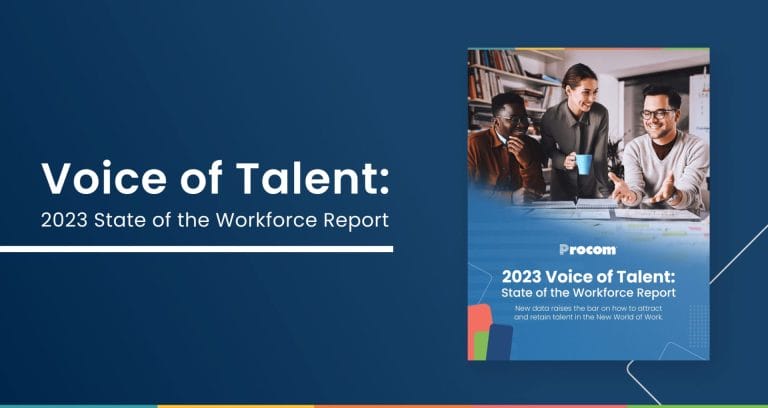The pandemic, combined with the Great Resignation and Great Reshuffle, triggered seismic changes in the workforce and greater job market. As the aftershocks continue to reverberate across the hiring landscape, it’s important that your organization’s workforce management and recruiting efforts are adapting efficiently and effectively to these developments.
As Procom re-imagined the recruitment playbook in this rapidly evolving climate, five key factors emerged as crucial to managing current fluctuations and preparing for a talent-centric future.
1. A talent focus on Total Compensation and Benefits
The recent economic recovery comes with the rise of a candidate driven market. As a result, business leaders are facing two particularly challenging market dynamics: An ever-changing total compensation and benefits landscape and the increasing competition for top candidates.
However, while benefits are typically a traditional, full-time employee focus, employers can leverage other aspects of the organization when engaging contingent talent such as a flexible work model or strong organizational culture.
Procom’s Voice of Talent Report found Flexibility is now as important as compensation for talent when choosing work opportunities – with equal numbers, 67% and 68% respectively citing each as ‘very important’.
In a labor market that is more competitive than ever, organizations must ensure rate cards and salary guides are up-to-date and that job postings accurately represent the role’s responsibilities.
Know your competition and update your employee value proposition (EVP) to highlight your strengths. Compensation and benefits are critical to job seekers, but they’re not the only thing that matters. Overpaying now could impact your ability to retain a valuable employee down the road.
2. The rise of project-based work
As organizational leaders and employees seek greater flexibility, many are embracing project-based work that focuses on outcomes instead of in-office hours.
The shift has some organizations expanding their workforces to meet demands and address skills gaps among existing employees. For many companies, the drive to project-based work has been fuelled by blended workforces or employee bases that utilize traditional, full-time employees as well as contingent or contract-based workers.
When administered strategically, a blended workforce offers benefits to employers and employees. It can be:
- Access quality talent
- Provide opportunities to upskill and reskill talent
- Provide flexibility
- Improve productivity
Operating a mix of traditional and contingent workers also requires that organizations understand and adhere to the specific obligations associated with each worker type.
Hiring leaders should also consider what type of worker — full-time employee, independent contractor or temporary personnel — is best suited for a project’s scope, skills and service demands. Each type of worker is accompanied by different payroll requirements and legal regulations that vary by locality.
3. The shift to a skills economy
The job losses and work-model changes that accompanied the pandemic’s peak spurred many workers to reconsider what was important to them in terms of their career progressions and work-life balance. The subsequent Great Resignation and Great Reshuffle saw millions of workers not just quit their jobs but take their skills to new organizations and fields that more closely reflect their interests and values.
The impacts on the workforce at large have hastened the transition from a knowledge economy to a skills economy, in which a job seeker’s skill set is more important than their formal education in a given sector. In a knowledge economy, productivity and advancement hinge on collective intellectual capital; a skills economy favors individual skill sets to power innovation.
Consider whether the skills required by a position demand a candidate with a college degree or can be performed by a talented worker who is self-taught and can pass a skills assessment. With workforce shortages impacting several industries and qualified candidates scarce, relevant skills are hot commodities.
The skills economy also relies on keeping the skill sets of an organization’s current workforce up to date. Companies can accomplish this through upskilling employees to hone their existing skills or reskilling workers to teach them new skills related to their roles and career arcs.
4. Transparency
From job descriptions to job postings to EVPs, transparency has become increasingly important to job seekers and legal compliance. The New York City Council, for example, recently approved a bill that will require employers with four or more workers to disclose salary information in job postings for positions based in the city; New York state just passed a similar salary transparency law, and other states and municipalities are expected to follow.
In Canada in an effort to address wage gaps, amendments made to the Employment Equity Act, cite businesses with more than 100 employees will be mandated to provide more detailed salary data that will be made public.
Being transparent about salary also accelerates the hiring process, decreases wage gaps and demonstrates clarity to job seekers. The latter is also true for job descriptions and job postings.
Candidates are seeking compelling reasons to take a role with a new organization. To connect with elite talent, companies must intentionally demonstrate their value to skilled candidates; this includes defining the organization’s purpose, culture, growth strategy and work-life balance.
This intentional transparency should extend to clarity about job requirements and expectations, the company’s work model and available benefits. Evaluate your current employee value proposition and job descriptions. Are they compelling, comprehensive and clear?
5. Remote and Hybrid Work Models
In a matter of weeks, the pandemic altered where and how many people work. As offices chose to reopen, most employees discovered they preferred a hybrid or fully remote work model.
To remain competitive in recruiting, organizations must offer some form of hybrid or remote model or risk losing talent. The primary approaches are:
- Hybrid, in which an employee splits time between an office and remote work.
- Work-from-home, in which an employee works entirely remotely but generally within the same city, state or province as the organization’s base.
- Work-from-anywhere, in which an employee works completely remotely from anywhere in the world.
It’s essential to communicate an organization’s chosen work model to job seekers so there is no confusion about how and where work is conducted and any tools necessary to perform work remotely. It’s also vital for employers who offer remote work to distinguish between work-from-home and work-from-anywhere models to avoid unexpected tax problems, residency issues or other regulatory challenges.
A New Horizon in Recruiting and Workforce Management
Events of recent years have permanently reshaped the workforce and transformed recruiting.
To access elite talent, organizations must re-evaluate their hiring and workforce management strategies and be proactive about engaging skilled candidates and retaining valuable workers. Further consideration of the five factors here marks a good starting point for adopting a talent-focused, future-ready plan.
Identifying and recruiting qualified talent in today’s climate requires dedication, resources and a sense of urgency. For many organizations, partnering with a staffing and workforce management agency provides numerous benefits, including access to a diverse talent pool, a proven screening process, onboarding assistance and scalability to meet future needs.
The Re-Imagined Recruitment Playbook
Over the past two years, we have captured hard won lessons learned across thousands of worker hiring engagements by our team of professional recruiters and distilled them into practical ideas that you can start using immediately. The Re-Imagined Recruitment Playbook is a step-by-step guide to help source, screen, select, onboard and retain talent in the New World of Work.





